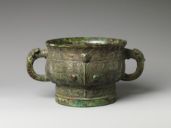Naturally brown, or crafted?
If you were to guess, what would you say our censer is made of? To us, at first glance its solid look and smooth texture recalls the weightiness and smoothness of stone, while its dark reddish-brown color reminds us of polished hardwood furniture.
It is actually made of bronze - which may not be obvious, because aged bronze objects usually have a greenish patina. Bronze is an alloy of copper and tin. The effects of time and deposition may lead to corrosion and discoloration of bronze, often appearing in patches of green and brown.
So what then gave our bronze censer its dark brown color and shiny texture? Presumably, the desired color of this bronze was achieved by chemically treating the surface after casting to imitate ancient patinas. This practice became fashionable during the reign of the Xuande Emperor (1425-1435) who commissioned the production of thousands of exquisite ritual and religious bronzes for the altars and halls of the newly constructed Forbidden City (a palace complex in Beijing) as well as to present to Tibetan emissaries. The surface colors produced ranged from russet hues and tea-brown to gunmetal grey, and surfaces mottled with greens and blacks. For both craftsmen and collectors the patina was a means of showing refinement and character to the object.
There are two types of patina: natural and artificial. The most sought after was the one that naturally developed over time. Patina is the surface coloration of bronze which results from the presence of an adherent layer formed by damage to the metal itself, especially through oxidation of copper. It can occur naturally from exposure to weather, air, oxygen, atmospheric agents, or soil over a long period of time. Artificially it can be obtained quickly by application of chemical reagents which are produced by combining chemical solutions of different natures: alkalis (ammonia, urine); acids (nitric acid, wine vinegar, acetic acid); sulphates (alum, mineral sulphur); salts (sodium chloride, ammonium chloride); and pigments (sanguine – hematite rock). Some of these reagents may also be diluted with water. The application methods generally used are hot or cold brushing, using a blowtorch or a brush. This process may be repeated until the desired color is achieved. It is also possible to apply patina by immersing the bronze in a bath of a solution. A final method involves enclosing the bronze in the hermetic container and spreading the solution by evaporation. Polishing is usually done with fine abrasives so that the bronze surface is lustrous. The final step is to apply a wax coating to halt the chemical reaction of the solution and to protect the surface from corrosion and loss of brightness, as well as to hide traces of tools used during manufacturing activities.
As for our bronze, we think that its finely crafted tea-brown color gives it a dignified (antique) look, while its smooth and shiny surface is inviting to the touch. If you wonder whether incense burners come in other media, shapes and sizes, find out in the next step.

](https://micrio.thingsthattalk.net/HZmAK/views/max/156x128.jpg)
](https://micrio.thingsthattalk.net/ZWYtk/views/max/163x128.jpg)